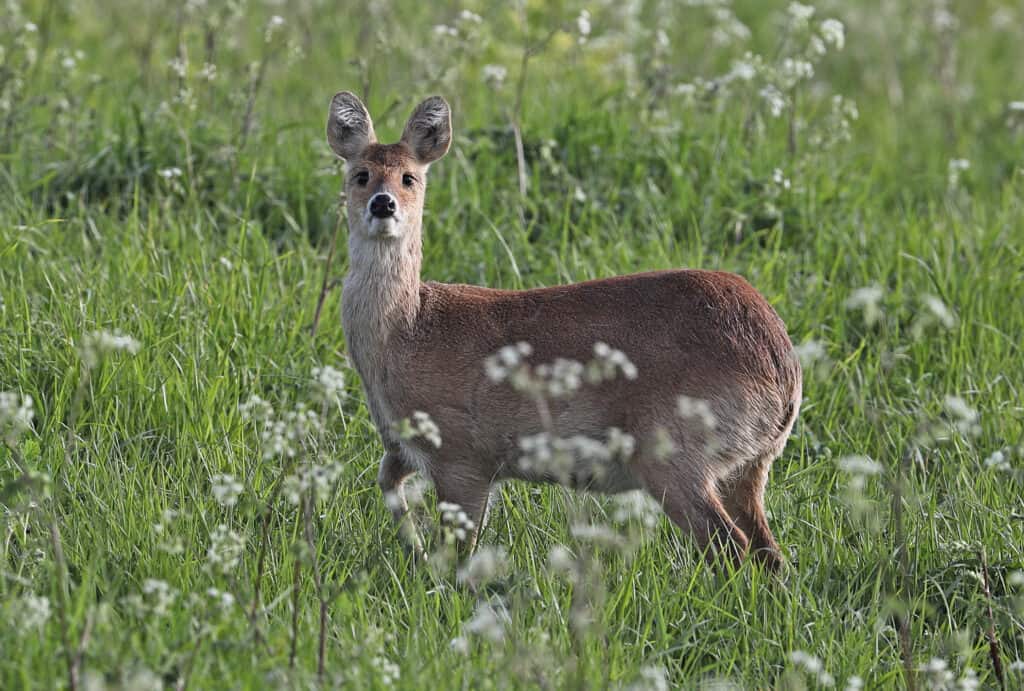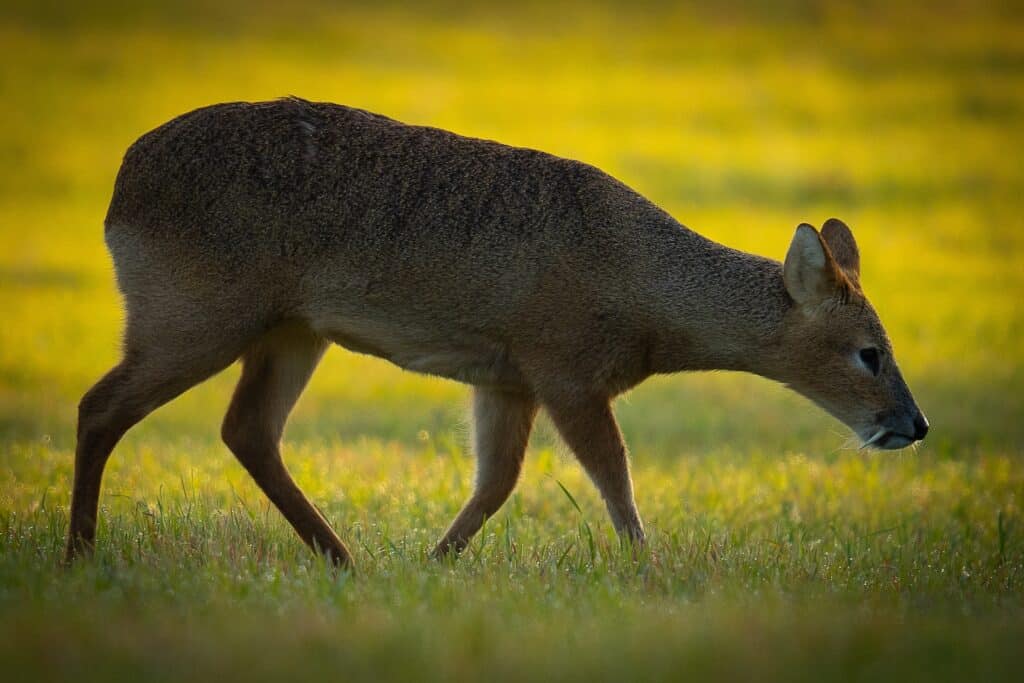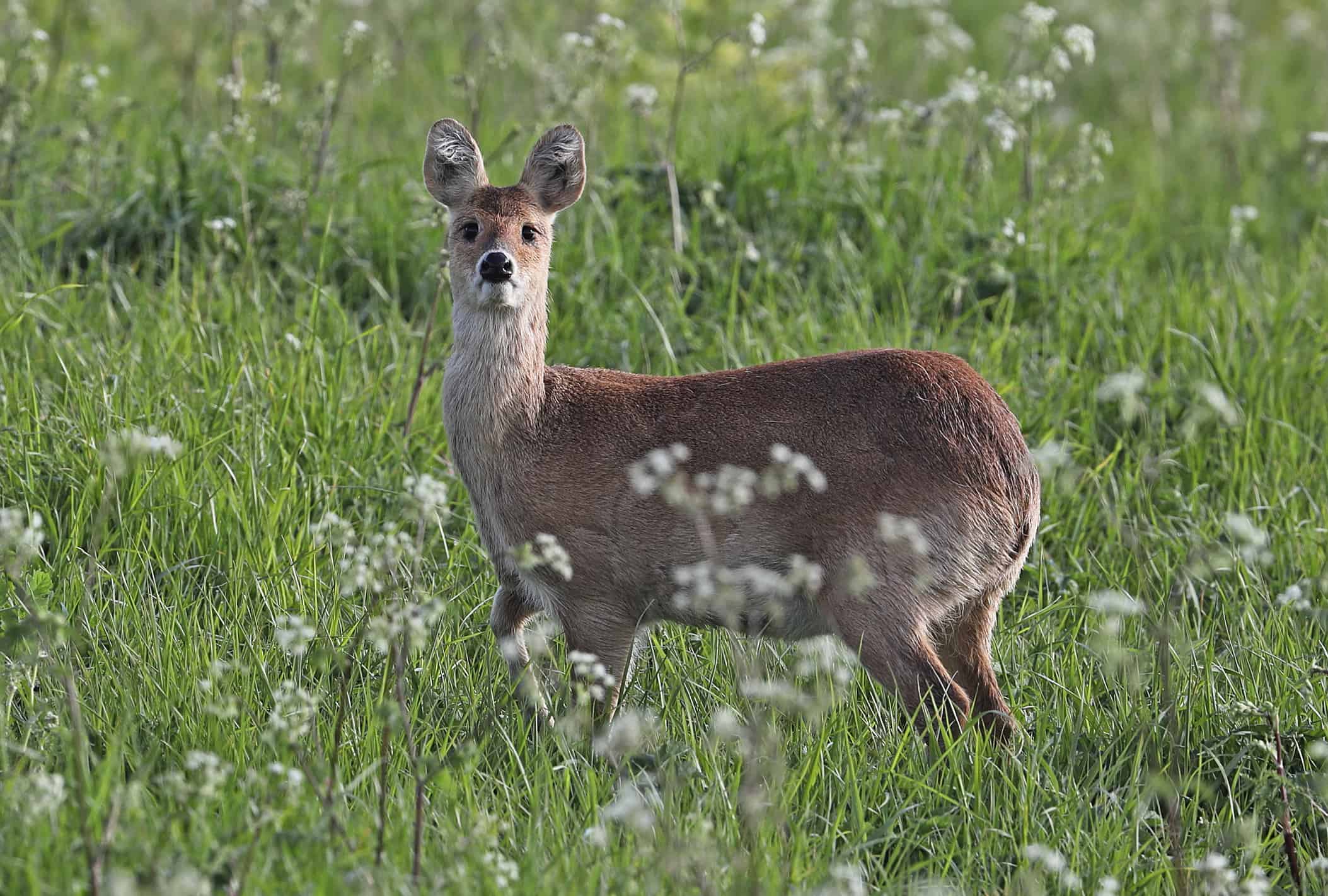We bet you’ve heard at least once about the vampire deer. But are they, in fact, “vampires?” Why do people call these deer species vampires?
We’ve done some research and found the answers! Keep reading to learn what they are called and their most notable characteristics!
What Are Vampire Deer?

Water deer have a golden brown coat mixed with some black hairs.
©Erni/Shutterstock.com
Vampire deer is a common name for the water deer species native to China and Korea. There are two water deer subspecies:
- Hydropotes inermis argyropus, commonly called Korean water deer
- Hydropotes inermis inermis, commonly called Chinese water deer.
They have received the “vampire deer” name because their canine teeth or tusks make them look like “vampires.” Moreover, these deer do not have antlers.
Water deer have a body length of up to 3.3 feet, a height of 18-22 inches at the shoulders, and a tail of up to 3 inches long. Most individuals weigh between 20 and 31 pounds. These deer have short rounded ears, long necks, and long legs. The hind legs are longer and more powerful and make them look like jumping rabbits when running.
Water deer have a golden brown coat mixed with some black hairs. They have white undersides, a reddish-brown or gray face, and cream-colored upper throats and chins. During the cold season, their coat changes, becoming thicker, coarser, and getting a grayish brown shade.
Where Do Vampire Deer Live?
Water deer are native to the following regions:
- The Yangtze River
- The coastal Jiangsu province
- Islands of Zhejiang in east-central China
- Korea
Chinese water deer live in Zhejiang, Hubei, Henan, Jiangsu, Anhui, Guangdong, Poyang Lakes in Jiangxi, Fujian, Shanghai, and Guangxi. Their population is critically endangered.
However, the Korean water deer population is thriving, as roughly 700,000 individuals live nationwide in South Korea.
These deer prefer living nearby rivers but may also be found in mountains, grasslands, swamps, and open cultivated fields.
Since the 1870s, Chinese water deer have lived in Great Britain too. Until 1986, water deer lived in the London Zoo. The Duke of Bedford transferred these deer to Woburn Abbey, Bedfordshire, imported other individuals and increased the population. Some thirty years later, 32 deer were transferred to Whipsnade. There are currently around 600 water deer at Whipsnade and 250 deer at Woburn.
Water Deer Behavior and Reproduction

Water deer are solitary animals.
©iStock.com/Simon Hutchinson
Water deer are solitary animals, especially bucks, which are highly territorial. They mark out their territories with urine and feces and bite off vegetation to outline the boundaries of their territories.
Female water deer are territorial only during the breeding season. Before and after giving birth, females can be quite aggressive and even chase other females. Otherwise, they like being in small groups.
During the breeding season, the male will follow the female and produce squeaking calls. One of the most important parts of deer courtship is sniffing the other.
Female water deer may give birth to as many as seven baby deer, but the average is 2-5.
Deer communicate through a sound called “bark,” used as an alarm.
Water Deer Teeth
Water deer have long canine teeth measuring 2.2-3.1 inches long in bucks and 0.2 inches long in does. They protrude from the deer’s upper jaw, like musk deer canines. The teeth grow during autumn, when the deer is approximately 6-7 months old, and reach half their size by spring. Since water deer are territorial animals, they use their tusks to fight for their territories. This is very common among males. They’ll try to wound the other deer on the shoulders or the head using their canines.
What Do Vampire Deer Eat?

Vampire deer eat grasses, reeds, vegetables, and beets.
©iStock.com/Neil Bowman
Vampire deer are herbivores. They eat grasses, reeds, vegetables, and beets. Deer most often choose low-fiber foods to facilitate digestion. They’ll eat young leaves and grasses, soft herbs and forbs, nuts, crops, and acorns. Some may even consider them pests because they eat crops and can destroy commercial forestry.
Are Vampire Deer Endangered?
Vampire deer are listed as “Vulnerable.” However, this status primarily refers to Chinese water deer, as only several thousand are in the wild. On the other hand, Korean water deer are abundant in South Korea, with roughly 700,000 individuals thriving on Korean lands. Their biggest predators, Korean tigers and leopards, almost completely disappeared from these territories. Korean water deer have even been called “harmful wildlife” because they were so many that they ended up harming humans and their property.
Are Vampire Deer Dangerous?

Vampire deer aren’t usually hostile or dangerous to humans.
©Wirestock Creators/Shutterstock.com
Vampire deer, or water deer, aren’t usually hostile or dangerous to humans. However, they may show aggression towards other water deer. It’s generally not recommended to feed deer or try to befriend them. After all, they are wild creatures who should only rely on wild habitats and “companionship.” Even more, it is well-known that feeding deer may harm their population rather than help it.
Other Unique Deer Species
Water deer isn’t the only interesting deer species; there are many others! In fact, each deer species is somewhat unique, especially if their population has albino or melanistic individuals! Here are some other species you should check out if you’re a deer enthusiast:
- Northern pudu – the smallest deer on the planet, looking almost like a plush toy!
- Indian muntjac – the deer with fewer chromosomes than any other mammals, having 7 for the male and 6 for the female;
- Pygmy brocket deer – this deer species lives only in Brazil, Argentina, and Paraguay; it’s extremely secretive, shy, and comes out only at night;
- Pampas deer – their uniqueness stands in their fearless nature and characteristic whistles they make when threatened;
- Truong Son muntjac – one of the smallest muntjac species discovered in Vietnam in 1997. It is called “samsoi cacoong,” meaning the deer living in deep, thick forests.
Up Next:
Thank you for reading! Have some feedback for us? Contact the AZ Animals editorial team.








